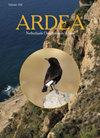极度干旱的撒哈拉和极度潮湿的几内亚森林中乔木鸟类的分布和数量
IF 0.8
4区 生物学
Q3 ORNITHOLOGY
引用次数: 9
摘要
本研究量化了2011-2019年旱季测量的干旱撒哈拉和潮湿几内亚之间过渡区50种树栖鸟类(17种食虫的非洲-北极移民和33种非洲-热带居民:20种食虫动物、7种食草动物和6种日光鸟)密度的空间变化。鸟类的分布与年降雨量有关,非洲-北极移民主要分布在相对干燥的地区,非洲-热带居民分布在更潮湿的地区。随着降雨量的增加,木本覆盖物的增加,干旱区的鸟类通常比湿润区的鸟类生活在更开阔的栖息地。当对降雨进行校正时,这种木质覆盖的影响很大程度上消失了。这些数据与分层随机地点的绝对鸟类数量有关,用于估计该地区的鸟类总数。为了评估这些估计的可靠性,根据半分割数据分别计算每个物种的种群规模。这两个估计值与为整个数据集计算的平均值相差约10%。在树栖鸟类(13.22亿只)中,食虫鸟类数量最多(5.47亿只),其次是食虫迁徙鸟类(3.26亿只)、蜜食鸟类(2.72亿只,以及食草鸟类(1.77亿只。数量最多的两种树栖鸟类是食虫性居民:褐色两侧的亚花Prinia(1.28亿只)和绿背Camaroptera Camaropterabrachyura(1.03亿只)。在迁徙者中,数量最多的三种是亚高山莺Curruca iberiae+亚高山莺+cantillans(6200万只)、小白喉莺Curruca Curruca(4800万只)和西部博内利莺Phylloscopus Bonelli(3000万只)。本文章由计算机程序翻译,如有差异,请以英文原文为准。
Distribution and Numbers of Arboreal Birds between the Hyper-Arid Sahara and the Hyper-Humid Guinea Forests
This study quantifies the spatial variation in the density of 50 arboreal bird species (17 insectivorous Afro-Palearctic migrants and 33 Afro-tropical residents: 20 insectivores, 7 frugivores and 6 sunbirds) in the transition zone between the arid Sahara and the humid Guinea zone, measured during the dry season in 2011–2019. The distribution of bird species was related to annual rainfall, with Afro-Palearctic migrants found mainly in the relatively dry zone and Afro-tropical residents in the more humid zone. As woody cover increases with rainfall, bird species from the dry zone are by default found in more open habitats than species from the humid zone. This effect of woody cover largely dissolves when corrected for rainfall. The data – pertaining to absolute bird counts in stratified random sites – were used to estimate the total number of birds in this region. To assess the reliability of these estimations, population sizes were calculated separately per species on half-split data. The two estimates deviated about 10% from the averages calculated for the full data set. Among arboreal birds (1322 million), insectivorous residents were most abundant (547 million), followed by insectivorous migrants (326 million), nectarivorous residents (272 million) and frugivorous residents (177 million). The two most numerous arboreal bird species were insectivorous residents: Tawny-flanked Prinia Prinia subflava (128 million) and Green-backed Camaroptera Camaroptera brachyura (103 million). Among the migrants, the three most abundant were Subalpine Warbler Curruca iberiae + subalpina + cantillans (62 million), Lesser Whitethroat Curruca curruca (48 million) and Western Bonelli's Warbler Phylloscopus bonelli (30 million).
求助全文
通过发布文献求助,成功后即可免费获取论文全文。
去求助
来源期刊

Ardea
生物-鸟类学
CiteScore
2.10
自引率
0.00%
发文量
49
审稿时长
>12 weeks
期刊介绍:
Ardea is the scientific journal of the Netherlands Ornithologists'' Union, and is published since 1912. The journal welcomes manuscripts reporting significant new findings in ornithology, in particular those covering the ecology, life history, and evolution of birds, and including sound descriptive work. Ardea publishes Original research papers, Short notes and Book reviews. In addition to the regular three issues per year, Ardea publishes specials that contain conference or workshop proceedings (produced on request).
 求助内容:
求助内容: 应助结果提醒方式:
应助结果提醒方式:


